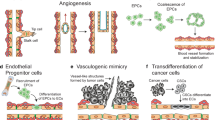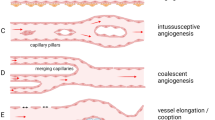Abstract
Integrin αvβ3 has an important role in the proliferation, survival, invasion and migration of vascular endothelial cells1,2. Like other integrins, αvβ3 can exist in different functional states with respect to ligand binding. These changes involve both affinity modulation, by which conformational changes in the integrin heterodimer govern affinity for individual extracellular matrix proteins, and avidity modulation, by which changes in lateral mobility and integrin clustering affect the binding of cells to multivalent matrices. Here we have used an engineered monoclonal antibody Fab (antigen-binding fragment) named WOW-1, which binds to activated integrins αvβ3 and αvβ5 from several species3, to investigate the role of αvβ3 activation in endothelial cell behaviour. Because WOW-1 is monovalent, it is insensitive to changes in integrin clustering and therefore reports only changes in affinity. WOW-1 contains an RGD tract in its variable region and binds only to unoccupied, high-affinity integrins. By using WOW-1, we have identified the selective recruitment of high-affinity integrins as a mechanism by which lamellipodia promote formation of new adhesions at the leading edge in cell migration.




Similar content being viewed by others
References
Byzova, T. V., Rabbani, R., D'Souza, S. & Plow, E. F. Thromb. Haemost. 80, 726–734 (1998).
Eliceiri, B. P. & Cheresh, D. A. Mol. Med. 4, 741–750 (1998).
Pampori, N. et al. J. Biol. Chem. 274, 21609–21616 (1999).
Smith, J. W., Vestal, D. J., Irwin, S. V., Burke, T. A. & Cheresh, D. A. J. Biol. Chem. 265, 11008 (1990).
Frelinger, A. L., Du, X., Plow, E. F. & Ginsberg, M. H. J. Biol. Chem. 266, 17106–17111 (1991).
Cheresh, D. A. & Spiro, R. C. J. Biol. Chem. 262, 1434–1437 (1987).
Tam, S. H., Sassoli, P. M., Jordan, R. E. & Nakada, M. T. Circulation 1085–1091 (1998).
Leavesley, D. I., Ferguson, G. D., Wayner, E. A. & Cheresh, D. A. J. Cell Biol. 117, 1101–1107 (1992).
Diaz-Gonzalez, F., Forsyth, J., Steiner, B. & Ginsberg, M. H. Mol. Biol. Cell 7, 1939–1951 (1996).
Blystone, S. D., Graham, I. L., Lindberg, F. P. & Brown, E. J. J. Cell Biol. 127, 1129–1137 (1994).
Shimizu, Y., Mobley, J. L., Finkelstein, L. D. & Chan, A. S. H. J. Cell Biol. 131, 1867–1880 (1995).
Zhang, J., Zhang, J., Shattil, S. J., Cunningham, M. C. & Rittenhouse, S. E. J. Biol. Chem. 271, 6265–6272 (1996).
Kovacsovics, T. J. et al. J. Biol. Chem. 270, 11358–11366 (1995).
Davis, P. D. et al. J. Med. Chem. 35, 994–1001 (1996).
Ridley, A. J., Paterson, H. F., Johnston, C. L., Diekmann, D. & Hall, A. Cell 70, 401–410 (1992).
Nobes, C. D. & Hall, A. J. Cell Biol. 144, 1235–1244 (1999).
Ridley, A. J., Allen, W. E., Peppelenbosch, M. & Jones, G. E. Biochem. Soc. Symp. 65, 111–123 (1999).
Hall, A. Science 279, 509–514 (1998).
Nobes, C. D. & Hall, A. Cell 81, 53–62 (1995).
Nishizaka, T., Shi, Q. & Sheetz, M. P. Proc. Natl Acad. Sci. USA 97, 692–697 (2000).
Du, X. et al. Cell 65, 409–416 (1991).
Savage, B., Shattil, S. J. & Ruggeri, Z. M. J. Biol. Chem. 267, 11300–11306 (1992).
Leavesley, D. I., Schwartz, M. A., Rosenfeld, M. & Cheresh, D. A. J. Cell Biol. 121, 163–170 (1993).
Schwartz, M. A. & Denninghoff, K. J. Biol. Chem. 269, 11133–11137 (1994).
Acknowledgements
We thank M. Ginsberg for providing polyclonal and LIBS anti-αvβ3 antibodies, and B. Cessna for secretarial assistance. This work was supported by US Public Health Service grants to M.A.S. and S.J.S., and an American Heart Association fellowship to W.B.K.
Author information
Authors and Affiliations
Corresponding author
Rights and permissions
About this article
Cite this article
Kiosses, W., Shattil, S., Pampori, N. et al. Rac recruits high-affinity integrin αvβ3 to lamellipodia in endothelial cell migration. Nat Cell Biol 3, 316–320 (2001). https://doi.org/10.1038/35060120
Received:
Revised:
Accepted:
Published:
Issue Date:
DOI: https://doi.org/10.1038/35060120
- Springer Nature Limited
This article is cited by
-
Indacaterol inhibits collective cell migration and IGDQ-mediated single cell migration in metastatic breast cancer MDA-MB-231 cells
Cell Communication and Signaling (2023)
-
Substrate engagement of integrins α5β1 and αvβ3 is necessary, but not sufficient, for high directional persistence in migration on fibronectin
Scientific Reports (2016)
-
Leader cells regulate collective cell migration via Rac activation in the downstream signaling of integrin β1 and PI3K
Scientific Reports (2015)
-
A RIAM/lamellipodin–talin–integrin complex forms the tip of sticky fingers that guide cell migration
Nature Communications (2015)
-
Caveolin-1 induces lamellipodia formation via an Akt-dependent pathway
Cancer Cell International (2014)





